IoT: A Report on Security and Privacy Issues in Cloud and Fog
VerifiedAdded on 2021/06/17
|8
|1892
|23
Report
AI Summary
This report examines the security and privacy challenges within the Internet of Things (IoT) when integrated with cloud and fog computing architectures. It highlights key vulnerabilities related to data integrity, confidentiality, and availability. Specifically, the report addresses weaknesses in validation practices, insecure backplane management, and the risks associated with location awareness in cloud-fog platforms. It also discusses the over-dependence on distributed images and the limited capabilities of fog nodes, making them susceptible to denial-of-service attacks. The report concludes by emphasizing the need for robust security measures to address these vulnerabilities and ensure the reliable and secure operation of IoT systems in cloud and fog environments. Desklib offers a platform for students to access this and other solved assignments.
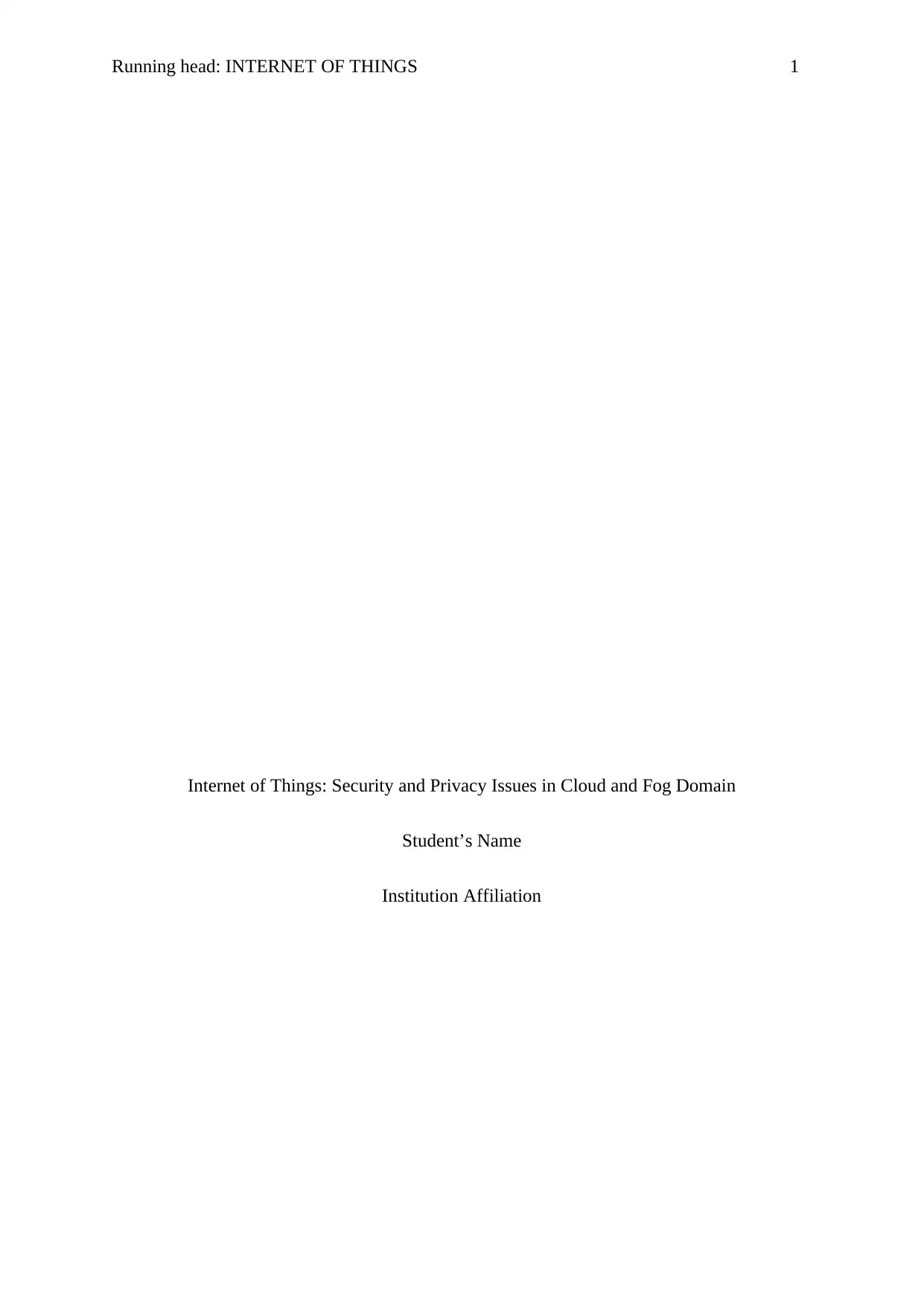
Running head: INTERNET OF THINGS 1
Internet of Things: Security and Privacy Issues in Cloud and Fog Domain
Student’s Name
Institution Affiliation
Internet of Things: Security and Privacy Issues in Cloud and Fog Domain
Student’s Name
Institution Affiliation
Paraphrase This Document
Need a fresh take? Get an instant paraphrase of this document with our AI Paraphraser
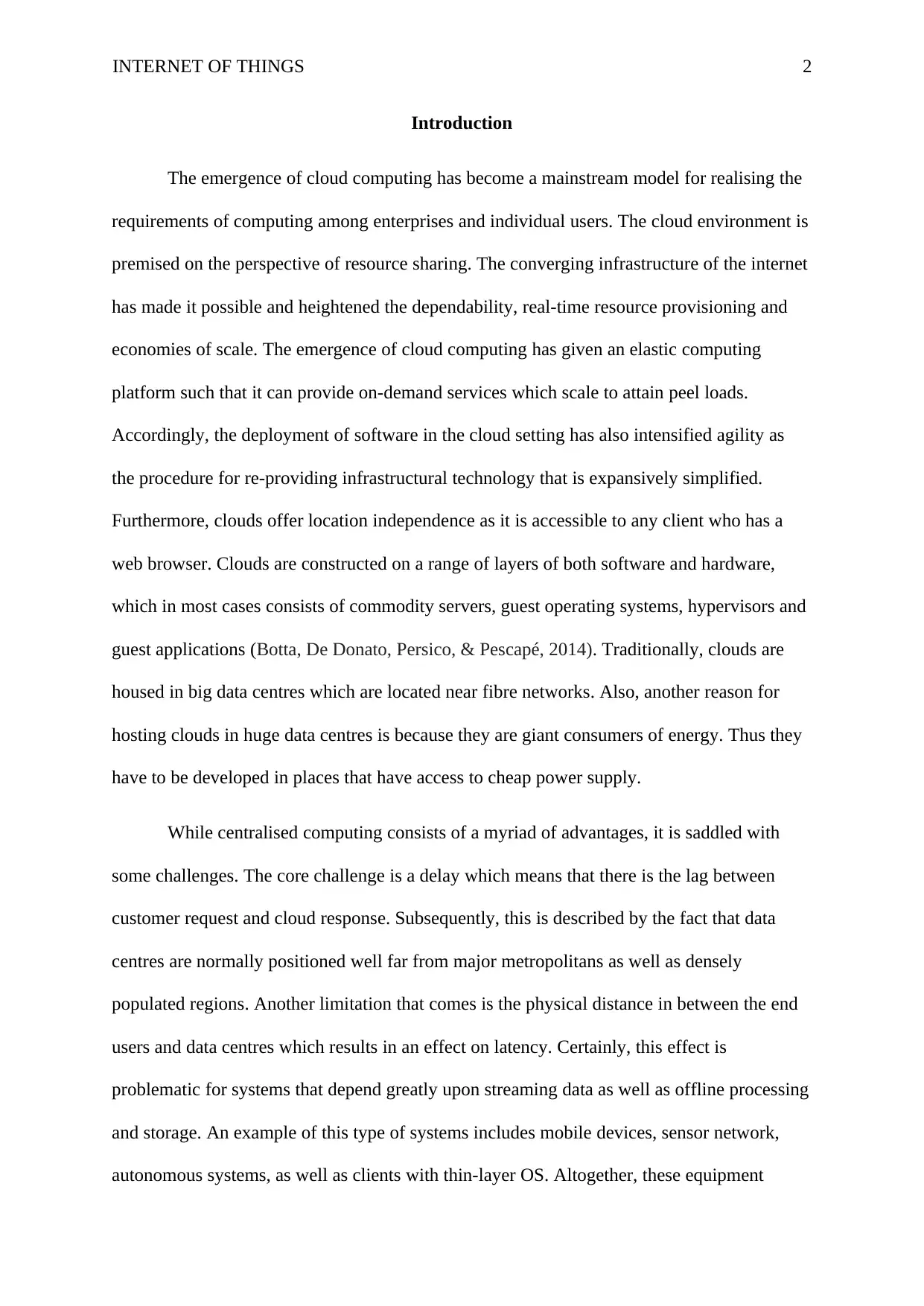
INTERNET OF THINGS 2
Introduction
The emergence of cloud computing has become a mainstream model for realising the
requirements of computing among enterprises and individual users. The cloud environment is
premised on the perspective of resource sharing. The converging infrastructure of the internet
has made it possible and heightened the dependability, real-time resource provisioning and
economies of scale. The emergence of cloud computing has given an elastic computing
platform such that it can provide on-demand services which scale to attain peel loads.
Accordingly, the deployment of software in the cloud setting has also intensified agility as
the procedure for re-providing infrastructural technology that is expansively simplified.
Furthermore, clouds offer location independence as it is accessible to any client who has a
web browser. Clouds are constructed on a range of layers of both software and hardware,
which in most cases consists of commodity servers, guest operating systems, hypervisors and
guest applications (Botta, De Donato, Persico, & Pescapé, 2014). Traditionally, clouds are
housed in big data centres which are located near fibre networks. Also, another reason for
hosting clouds in huge data centres is because they are giant consumers of energy. Thus they
have to be developed in places that have access to cheap power supply.
While centralised computing consists of a myriad of advantages, it is saddled with
some challenges. The core challenge is a delay which means that there is the lag between
customer request and cloud response. Subsequently, this is described by the fact that data
centres are normally positioned well far from major metropolitans as well as densely
populated regions. Another limitation that comes is the physical distance in between the end
users and data centres which results in an effect on latency. Certainly, this effect is
problematic for systems that depend greatly upon streaming data as well as offline processing
and storage. An example of this type of systems includes mobile devices, sensor network,
autonomous systems, as well as clients with thin-layer OS. Altogether, these equipment
Introduction
The emergence of cloud computing has become a mainstream model for realising the
requirements of computing among enterprises and individual users. The cloud environment is
premised on the perspective of resource sharing. The converging infrastructure of the internet
has made it possible and heightened the dependability, real-time resource provisioning and
economies of scale. The emergence of cloud computing has given an elastic computing
platform such that it can provide on-demand services which scale to attain peel loads.
Accordingly, the deployment of software in the cloud setting has also intensified agility as
the procedure for re-providing infrastructural technology that is expansively simplified.
Furthermore, clouds offer location independence as it is accessible to any client who has a
web browser. Clouds are constructed on a range of layers of both software and hardware,
which in most cases consists of commodity servers, guest operating systems, hypervisors and
guest applications (Botta, De Donato, Persico, & Pescapé, 2014). Traditionally, clouds are
housed in big data centres which are located near fibre networks. Also, another reason for
hosting clouds in huge data centres is because they are giant consumers of energy. Thus they
have to be developed in places that have access to cheap power supply.
While centralised computing consists of a myriad of advantages, it is saddled with
some challenges. The core challenge is a delay which means that there is the lag between
customer request and cloud response. Subsequently, this is described by the fact that data
centres are normally positioned well far from major metropolitans as well as densely
populated regions. Another limitation that comes is the physical distance in between the end
users and data centres which results in an effect on latency. Certainly, this effect is
problematic for systems that depend greatly upon streaming data as well as offline processing
and storage. An example of this type of systems includes mobile devices, sensor network,
autonomous systems, as well as clients with thin-layer OS. Altogether, these equipment
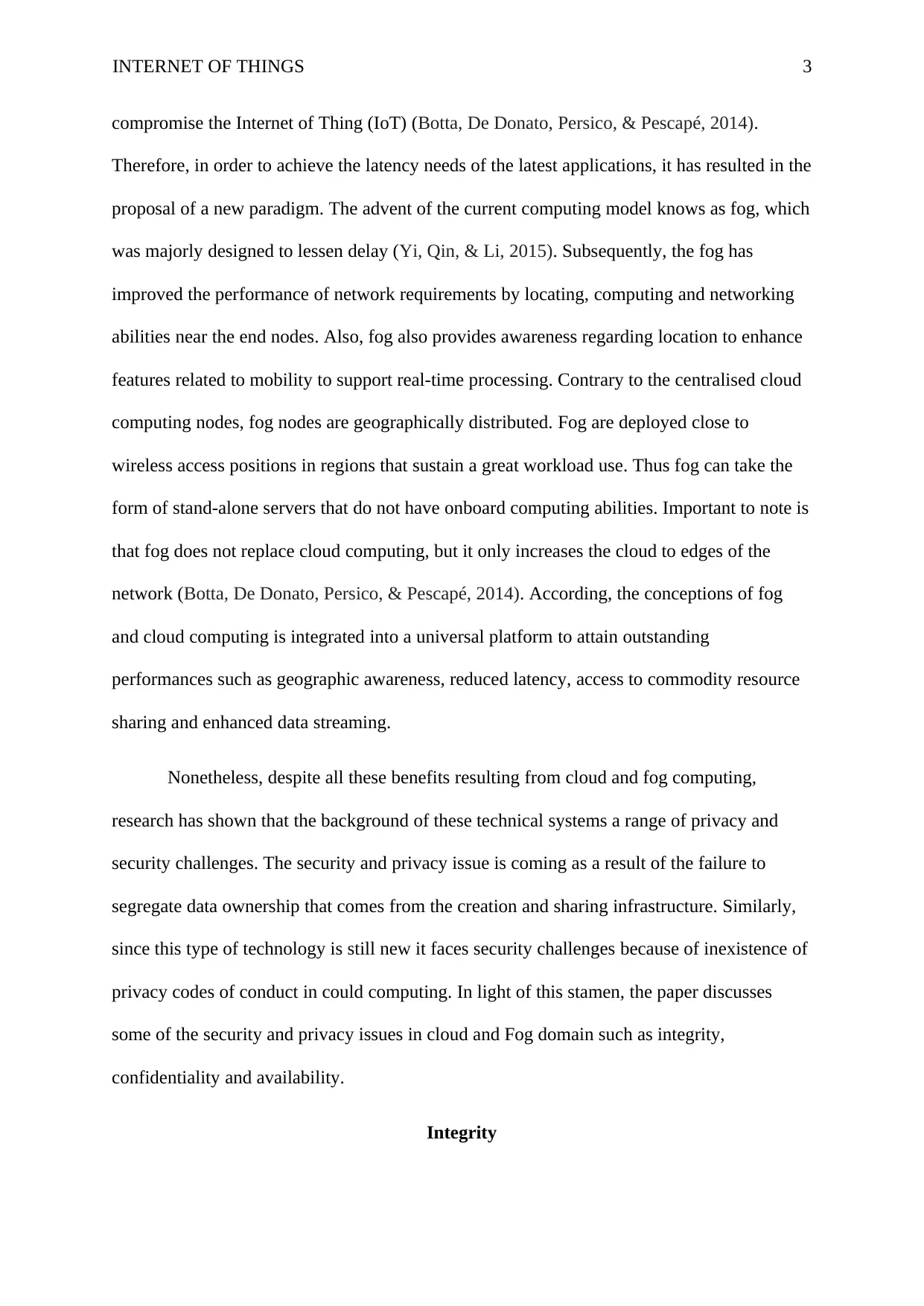
INTERNET OF THINGS 3
compromise the Internet of Thing (IoT) (Botta, De Donato, Persico, & Pescapé, 2014).
Therefore, in order to achieve the latency needs of the latest applications, it has resulted in the
proposal of a new paradigm. The advent of the current computing model knows as fog, which
was majorly designed to lessen delay (Yi, Qin, & Li, 2015). Subsequently, the fog has
improved the performance of network requirements by locating, computing and networking
abilities near the end nodes. Also, fog also provides awareness regarding location to enhance
features related to mobility to support real-time processing. Contrary to the centralised cloud
computing nodes, fog nodes are geographically distributed. Fog are deployed close to
wireless access positions in regions that sustain a great workload use. Thus fog can take the
form of stand-alone servers that do not have onboard computing abilities. Important to note is
that fog does not replace cloud computing, but it only increases the cloud to edges of the
network (Botta, De Donato, Persico, & Pescapé, 2014). According, the conceptions of fog
and cloud computing is integrated into a universal platform to attain outstanding
performances such as geographic awareness, reduced latency, access to commodity resource
sharing and enhanced data streaming.
Nonetheless, despite all these benefits resulting from cloud and fog computing,
research has shown that the background of these technical systems a range of privacy and
security challenges. The security and privacy issue is coming as a result of the failure to
segregate data ownership that comes from the creation and sharing infrastructure. Similarly,
since this type of technology is still new it faces security challenges because of inexistence of
privacy codes of conduct in could computing. In light of this stamen, the paper discusses
some of the security and privacy issues in cloud and Fog domain such as integrity,
confidentiality and availability.
Integrity
compromise the Internet of Thing (IoT) (Botta, De Donato, Persico, & Pescapé, 2014).
Therefore, in order to achieve the latency needs of the latest applications, it has resulted in the
proposal of a new paradigm. The advent of the current computing model knows as fog, which
was majorly designed to lessen delay (Yi, Qin, & Li, 2015). Subsequently, the fog has
improved the performance of network requirements by locating, computing and networking
abilities near the end nodes. Also, fog also provides awareness regarding location to enhance
features related to mobility to support real-time processing. Contrary to the centralised cloud
computing nodes, fog nodes are geographically distributed. Fog are deployed close to
wireless access positions in regions that sustain a great workload use. Thus fog can take the
form of stand-alone servers that do not have onboard computing abilities. Important to note is
that fog does not replace cloud computing, but it only increases the cloud to edges of the
network (Botta, De Donato, Persico, & Pescapé, 2014). According, the conceptions of fog
and cloud computing is integrated into a universal platform to attain outstanding
performances such as geographic awareness, reduced latency, access to commodity resource
sharing and enhanced data streaming.
Nonetheless, despite all these benefits resulting from cloud and fog computing,
research has shown that the background of these technical systems a range of privacy and
security challenges. The security and privacy issue is coming as a result of the failure to
segregate data ownership that comes from the creation and sharing infrastructure. Similarly,
since this type of technology is still new it faces security challenges because of inexistence of
privacy codes of conduct in could computing. In light of this stamen, the paper discusses
some of the security and privacy issues in cloud and Fog domain such as integrity,
confidentiality and availability.
Integrity
⊘ This is a preview!⊘
Do you want full access?
Subscribe today to unlock all pages.

Trusted by 1+ million students worldwide
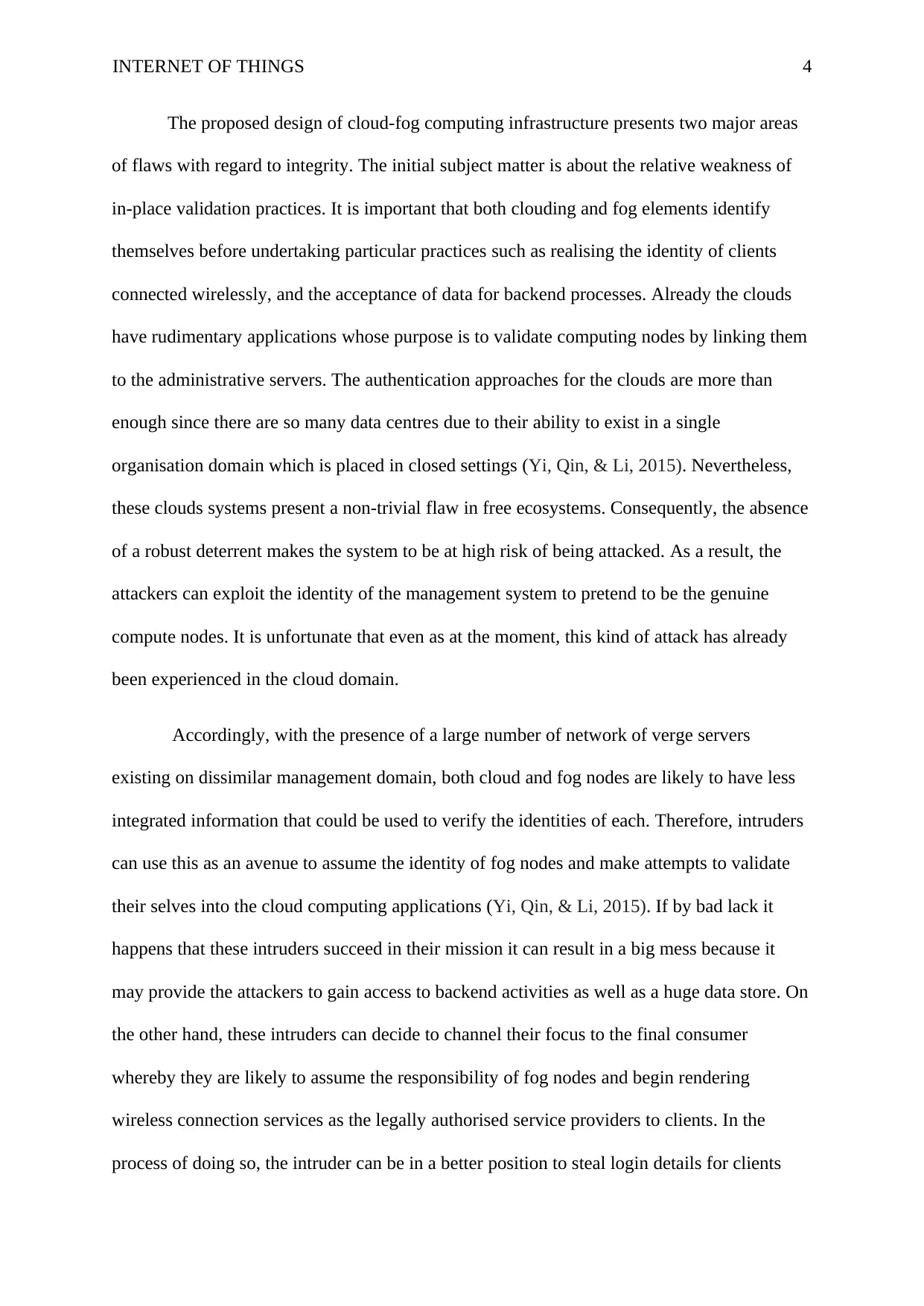
INTERNET OF THINGS 4
The proposed design of cloud-fog computing infrastructure presents two major areas
of flaws with regard to integrity. The initial subject matter is about the relative weakness of
in-place validation practices. It is important that both clouding and fog elements identify
themselves before undertaking particular practices such as realising the identity of clients
connected wirelessly, and the acceptance of data for backend processes. Already the clouds
have rudimentary applications whose purpose is to validate computing nodes by linking them
to the administrative servers. The authentication approaches for the clouds are more than
enough since there are so many data centres due to their ability to exist in a single
organisation domain which is placed in closed settings (Yi, Qin, & Li, 2015). Nevertheless,
these clouds systems present a non-trivial flaw in free ecosystems. Consequently, the absence
of a robust deterrent makes the system to be at high risk of being attacked. As a result, the
attackers can exploit the identity of the management system to pretend to be the genuine
compute nodes. It is unfortunate that even as at the moment, this kind of attack has already
been experienced in the cloud domain.
Accordingly, with the presence of a large number of network of verge servers
existing on dissimilar management domain, both cloud and fog nodes are likely to have less
integrated information that could be used to verify the identities of each. Therefore, intruders
can use this as an avenue to assume the identity of fog nodes and make attempts to validate
their selves into the cloud computing applications (Yi, Qin, & Li, 2015). If by bad lack it
happens that these intruders succeed in their mission it can result in a big mess because it
may provide the attackers to gain access to backend activities as well as a huge data store. On
the other hand, these intruders can decide to channel their focus to the final consumer
whereby they are likely to assume the responsibility of fog nodes and begin rendering
wireless connection services as the legally authorised service providers to clients. In the
process of doing so, the intruder can be in a better position to steal login details for clients
The proposed design of cloud-fog computing infrastructure presents two major areas
of flaws with regard to integrity. The initial subject matter is about the relative weakness of
in-place validation practices. It is important that both clouding and fog elements identify
themselves before undertaking particular practices such as realising the identity of clients
connected wirelessly, and the acceptance of data for backend processes. Already the clouds
have rudimentary applications whose purpose is to validate computing nodes by linking them
to the administrative servers. The authentication approaches for the clouds are more than
enough since there are so many data centres due to their ability to exist in a single
organisation domain which is placed in closed settings (Yi, Qin, & Li, 2015). Nevertheless,
these clouds systems present a non-trivial flaw in free ecosystems. Consequently, the absence
of a robust deterrent makes the system to be at high risk of being attacked. As a result, the
attackers can exploit the identity of the management system to pretend to be the genuine
compute nodes. It is unfortunate that even as at the moment, this kind of attack has already
been experienced in the cloud domain.
Accordingly, with the presence of a large number of network of verge servers
existing on dissimilar management domain, both cloud and fog nodes are likely to have less
integrated information that could be used to verify the identities of each. Therefore, intruders
can use this as an avenue to assume the identity of fog nodes and make attempts to validate
their selves into the cloud computing applications (Yi, Qin, & Li, 2015). If by bad lack it
happens that these intruders succeed in their mission it can result in a big mess because it
may provide the attackers to gain access to backend activities as well as a huge data store. On
the other hand, these intruders can decide to channel their focus to the final consumer
whereby they are likely to assume the responsibility of fog nodes and begin rendering
wireless connection services as the legally authorised service providers to clients. In the
process of doing so, the intruder can be in a better position to steal login details for clients
Paraphrase This Document
Need a fresh take? Get an instant paraphrase of this document with our AI Paraphraser
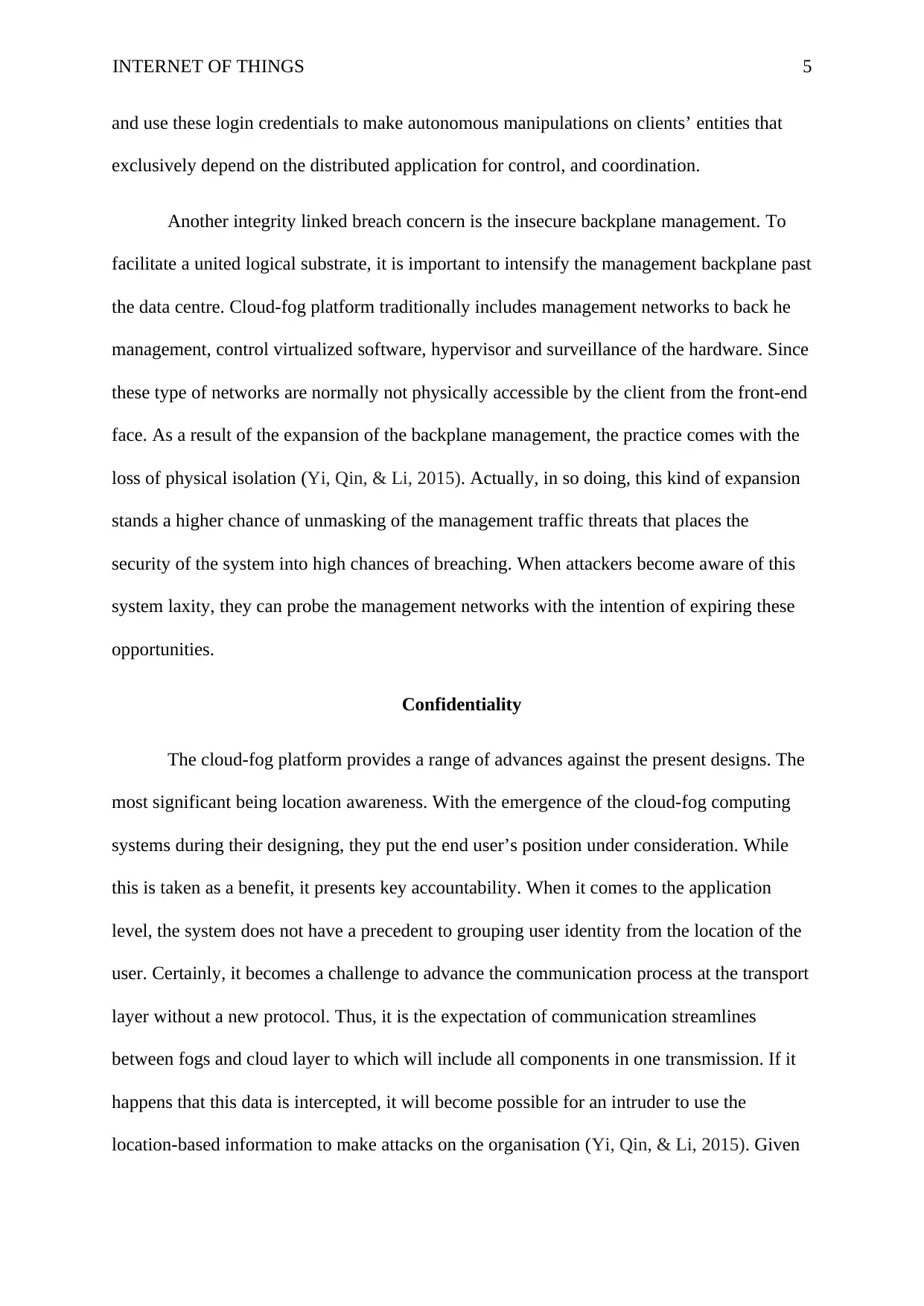
INTERNET OF THINGS 5
and use these login credentials to make autonomous manipulations on clients’ entities that
exclusively depend on the distributed application for control, and coordination.
Another integrity linked breach concern is the insecure backplane management. To
facilitate a united logical substrate, it is important to intensify the management backplane past
the data centre. Cloud-fog platform traditionally includes management networks to back he
management, control virtualized software, hypervisor and surveillance of the hardware. Since
these type of networks are normally not physically accessible by the client from the front-end
face. As a result of the expansion of the backplane management, the practice comes with the
loss of physical isolation (Yi, Qin, & Li, 2015). Actually, in so doing, this kind of expansion
stands a higher chance of unmasking of the management traffic threats that places the
security of the system into high chances of breaching. When attackers become aware of this
system laxity, they can probe the management networks with the intention of expiring these
opportunities.
Confidentiality
The cloud-fog platform provides a range of advances against the present designs. The
most significant being location awareness. With the emergence of the cloud-fog computing
systems during their designing, they put the end user’s position under consideration. While
this is taken as a benefit, it presents key accountability. When it comes to the application
level, the system does not have a precedent to grouping user identity from the location of the
user. Certainly, it becomes a challenge to advance the communication process at the transport
layer without a new protocol. Thus, it is the expectation of communication streamlines
between fogs and cloud layer to which will include all components in one transmission. If it
happens that this data is intercepted, it will become possible for an intruder to use the
location-based information to make attacks on the organisation (Yi, Qin, & Li, 2015). Given
and use these login credentials to make autonomous manipulations on clients’ entities that
exclusively depend on the distributed application for control, and coordination.
Another integrity linked breach concern is the insecure backplane management. To
facilitate a united logical substrate, it is important to intensify the management backplane past
the data centre. Cloud-fog platform traditionally includes management networks to back he
management, control virtualized software, hypervisor and surveillance of the hardware. Since
these type of networks are normally not physically accessible by the client from the front-end
face. As a result of the expansion of the backplane management, the practice comes with the
loss of physical isolation (Yi, Qin, & Li, 2015). Actually, in so doing, this kind of expansion
stands a higher chance of unmasking of the management traffic threats that places the
security of the system into high chances of breaching. When attackers become aware of this
system laxity, they can probe the management networks with the intention of expiring these
opportunities.
Confidentiality
The cloud-fog platform provides a range of advances against the present designs. The
most significant being location awareness. With the emergence of the cloud-fog computing
systems during their designing, they put the end user’s position under consideration. While
this is taken as a benefit, it presents key accountability. When it comes to the application
level, the system does not have a precedent to grouping user identity from the location of the
user. Certainly, it becomes a challenge to advance the communication process at the transport
layer without a new protocol. Thus, it is the expectation of communication streamlines
between fogs and cloud layer to which will include all components in one transmission. If it
happens that this data is intercepted, it will become possible for an intruder to use the
location-based information to make attacks on the organisation (Yi, Qin, & Li, 2015). Given
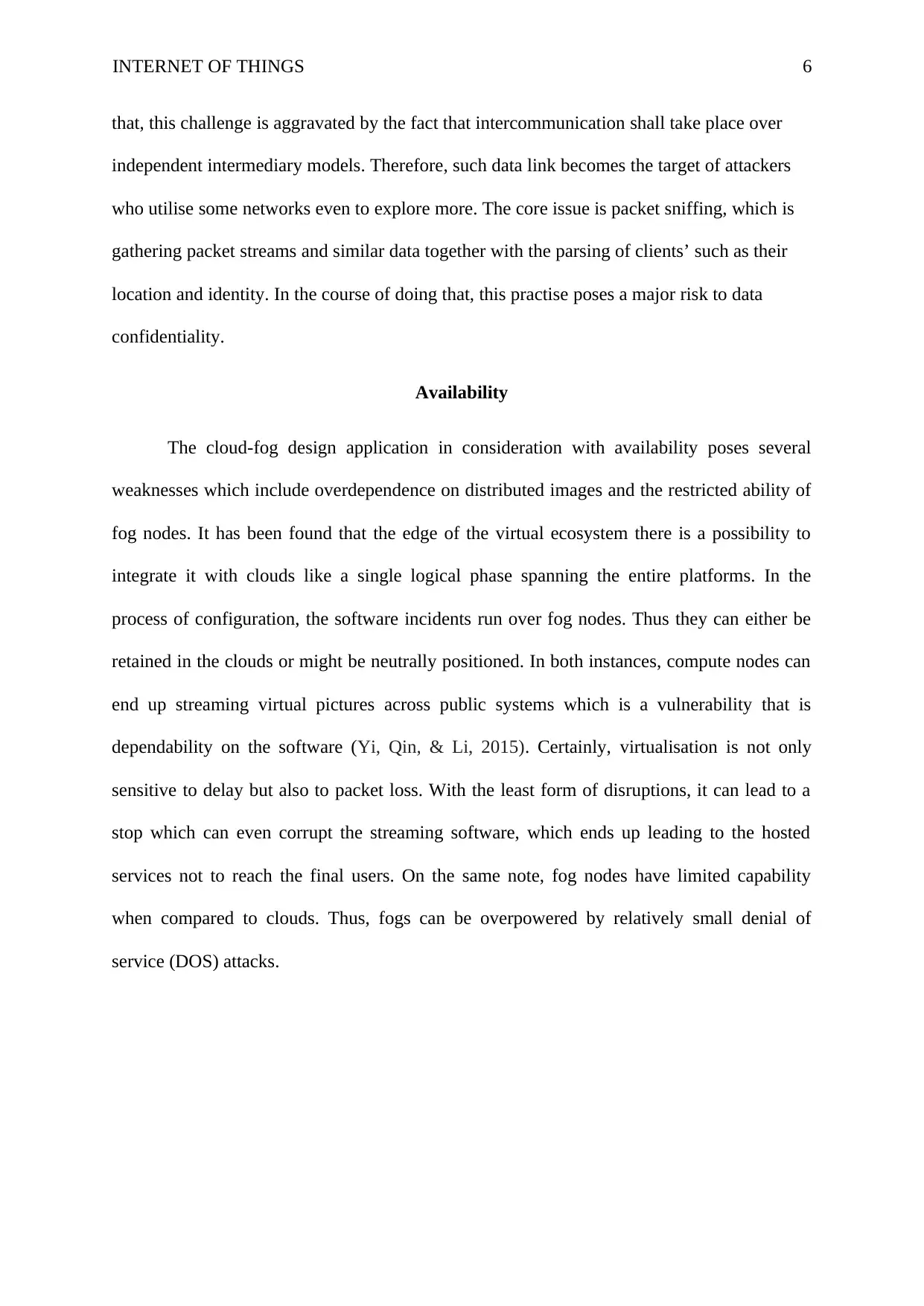
INTERNET OF THINGS 6
that, this challenge is aggravated by the fact that intercommunication shall take place over
independent intermediary models. Therefore, such data link becomes the target of attackers
who utilise some networks even to explore more. The core issue is packet sniffing, which is
gathering packet streams and similar data together with the parsing of clients’ such as their
location and identity. In the course of doing that, this practise poses a major risk to data
confidentiality.
Availability
The cloud-fog design application in consideration with availability poses several
weaknesses which include overdependence on distributed images and the restricted ability of
fog nodes. It has been found that the edge of the virtual ecosystem there is a possibility to
integrate it with clouds like a single logical phase spanning the entire platforms. In the
process of configuration, the software incidents run over fog nodes. Thus they can either be
retained in the clouds or might be neutrally positioned. In both instances, compute nodes can
end up streaming virtual pictures across public systems which is a vulnerability that is
dependability on the software (Yi, Qin, & Li, 2015). Certainly, virtualisation is not only
sensitive to delay but also to packet loss. With the least form of disruptions, it can lead to a
stop which can even corrupt the streaming software, which ends up leading to the hosted
services not to reach the final users. On the same note, fog nodes have limited capability
when compared to clouds. Thus, fogs can be overpowered by relatively small denial of
service (DOS) attacks.
that, this challenge is aggravated by the fact that intercommunication shall take place over
independent intermediary models. Therefore, such data link becomes the target of attackers
who utilise some networks even to explore more. The core issue is packet sniffing, which is
gathering packet streams and similar data together with the parsing of clients’ such as their
location and identity. In the course of doing that, this practise poses a major risk to data
confidentiality.
Availability
The cloud-fog design application in consideration with availability poses several
weaknesses which include overdependence on distributed images and the restricted ability of
fog nodes. It has been found that the edge of the virtual ecosystem there is a possibility to
integrate it with clouds like a single logical phase spanning the entire platforms. In the
process of configuration, the software incidents run over fog nodes. Thus they can either be
retained in the clouds or might be neutrally positioned. In both instances, compute nodes can
end up streaming virtual pictures across public systems which is a vulnerability that is
dependability on the software (Yi, Qin, & Li, 2015). Certainly, virtualisation is not only
sensitive to delay but also to packet loss. With the least form of disruptions, it can lead to a
stop which can even corrupt the streaming software, which ends up leading to the hosted
services not to reach the final users. On the same note, fog nodes have limited capability
when compared to clouds. Thus, fogs can be overpowered by relatively small denial of
service (DOS) attacks.
⊘ This is a preview!⊘
Do you want full access?
Subscribe today to unlock all pages.

Trusted by 1+ million students worldwide
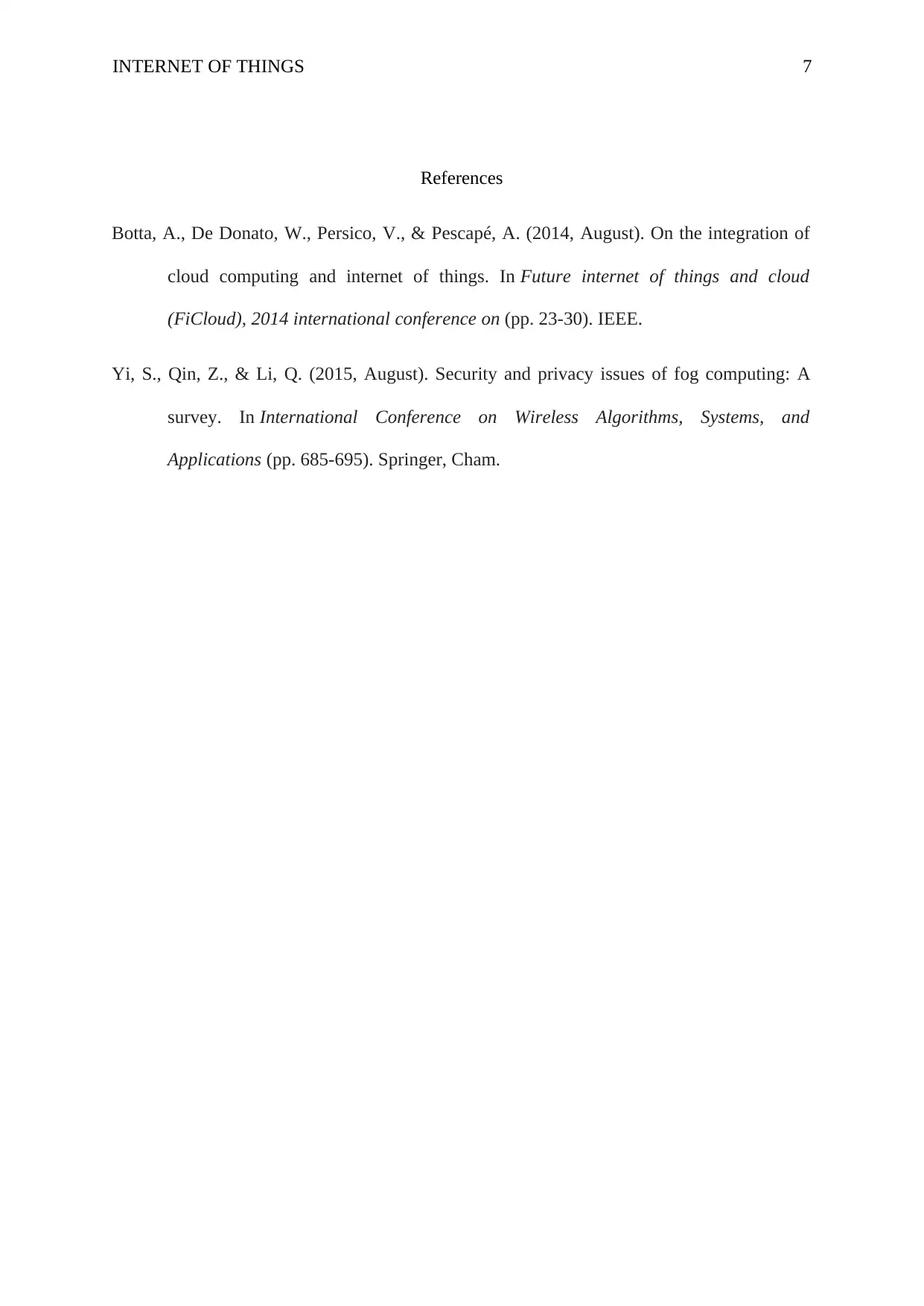
INTERNET OF THINGS 7
References
Botta, A., De Donato, W., Persico, V., & Pescapé, A. (2014, August). On the integration of
cloud computing and internet of things. In Future internet of things and cloud
(FiCloud), 2014 international conference on (pp. 23-30). IEEE.
Yi, S., Qin, Z., & Li, Q. (2015, August). Security and privacy issues of fog computing: A
survey. In International Conference on Wireless Algorithms, Systems, and
Applications (pp. 685-695). Springer, Cham.
References
Botta, A., De Donato, W., Persico, V., & Pescapé, A. (2014, August). On the integration of
cloud computing and internet of things. In Future internet of things and cloud
(FiCloud), 2014 international conference on (pp. 23-30). IEEE.
Yi, S., Qin, Z., & Li, Q. (2015, August). Security and privacy issues of fog computing: A
survey. In International Conference on Wireless Algorithms, Systems, and
Applications (pp. 685-695). Springer, Cham.
Paraphrase This Document
Need a fresh take? Get an instant paraphrase of this document with our AI Paraphraser
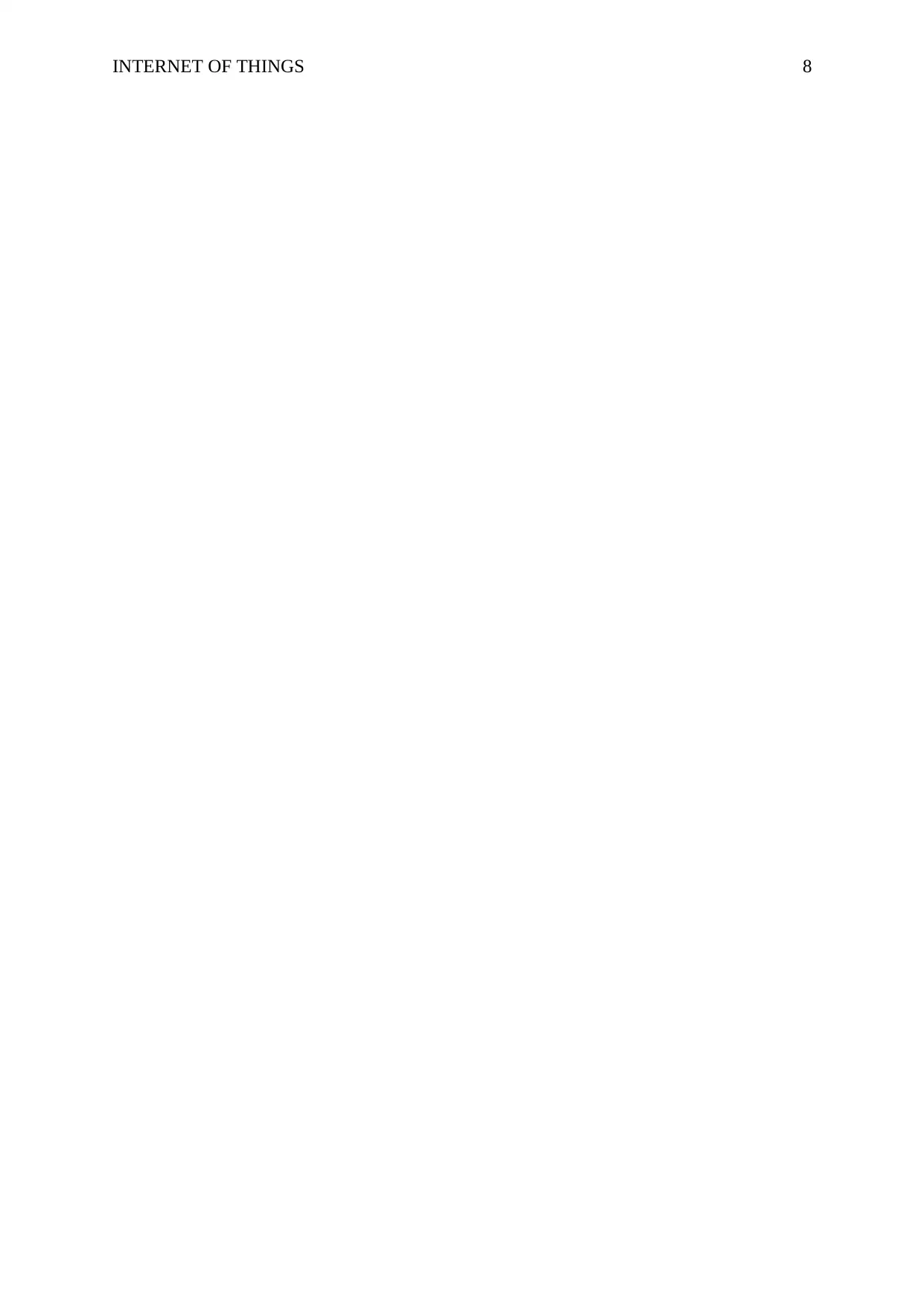
INTERNET OF THINGS 8
1 out of 8
Related Documents
Your All-in-One AI-Powered Toolkit for Academic Success.
+13062052269
info@desklib.com
Available 24*7 on WhatsApp / Email
![[object Object]](/_next/static/media/star-bottom.7253800d.svg)
Unlock your academic potential
Copyright © 2020–2025 A2Z Services. All Rights Reserved. Developed and managed by ZUCOL.





